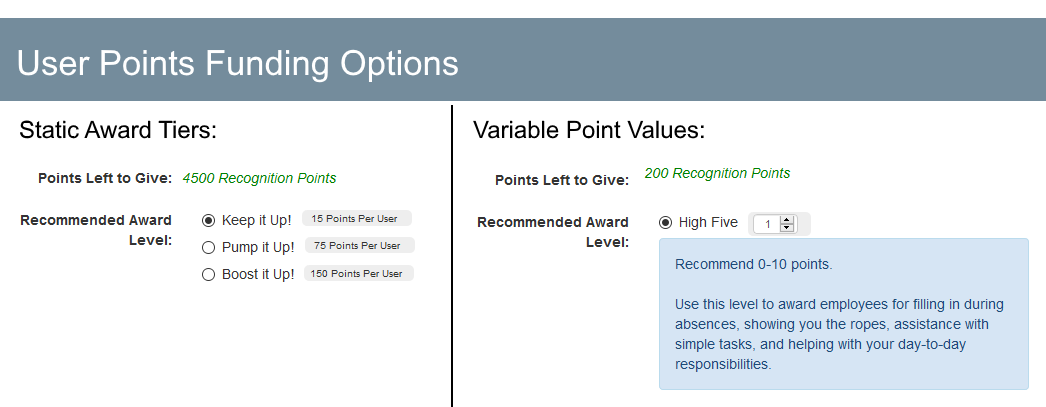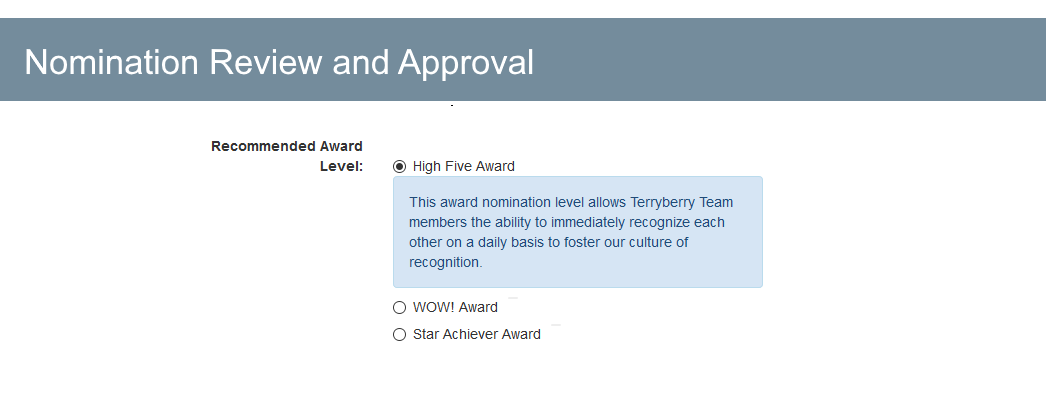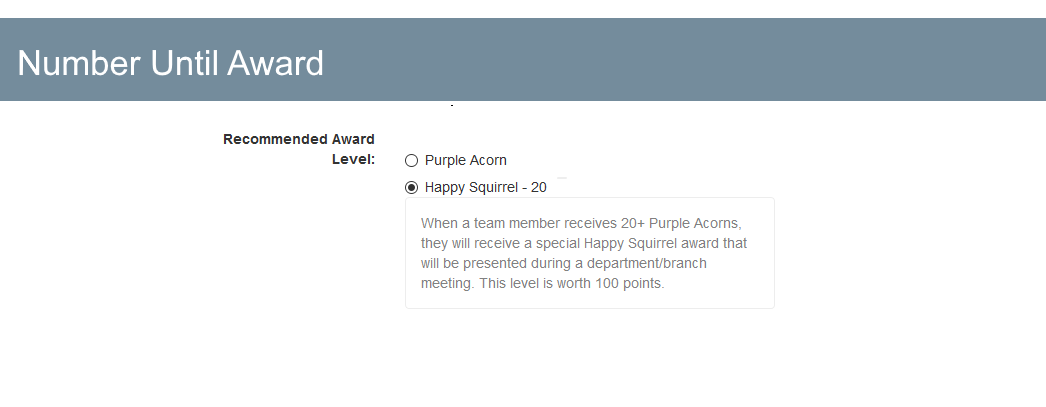With years of first-hand experience under our belts, Terryberry’s dedicated 360 Recognition specialists know the ins and outs of what makes a peer to peer recognition program work, and equally importantly what doesn’t. Today we’re going to examine the three most frequently used setup options, and the pros and pitfalls for each.
User Points Funding
Despite its incredibly exciting name, User Points Funding is the most popular and, statistically, most engaging setup option for a Peer to peer recognition program. User Points Funding allows each employee to be assigned a small budget of points which they are allowed to freely award to their peers. Users can only award the points they’ve been assigned and cannot overspend their budget. Points can be awarded through multiple awards set up at tiered points values, or through a singular award level with a variable point value selected by the user.

Pros:
Using a Points Funding setup empowers your users and makes them responsible for the award value assigned to their peers. Time and time again, we’ve witnessed outstanding participation from employees using this type of program setup. The ownership and control they have over assigning an actual value to their peers keeps employees invested in the program and drives frequent and regular recognition activity.
A Points Funding setup requires less administrative effort, as employees have a controlled measure of autonomy. Other setups may require putting some sort of review and approval process in place for awards that have a monetary value associated with them.
With Points Funding, you have complete control over your budget and the maximum exposure that would occur due to the recognition employees send each other through the system.
It’s very easy to build in additional award options and points funding for supervisors, managers, and any other leaders that may wish to provide additional spot recognition due to their leadership position.
Pitfalls:
Points Funding requires you to be comfortable with your employees having control over a small budget, and the autonomy to recognize their coworkers as they see fit. If you are uncomfortable giving your employees this responsibility, another setup option may be the most beneficial for you.
Nomination Review and Approval
Nomination Review and Approval was really how Give a Wow, our peer to peer program, got its start. We wanted to create an outlet for immediate day to day recognition between employees that allowed for immediate social recognition without award redemption, while at the same time creating opportunities for informal and formal awards with a tangible award value to be given through the same process. We designed a tiered award process on the nomination page, where employees could nominate their peers for multiple award levels. The approval of that award would be determined by the criteria specified by our customers for their program, and the nomination would be sent to an Approval Queue to be reviewed by the required authority.

Pros:
A Nomination Review and Approval program allows for an additional measure of control when assigning monetary award value to employees. Managers, Executives, Administrators, or Committees have the ability to determine which nominations are worthy of an award and maintain consistent standards for the issuance of award value.
This type of program setup allows for a structured recognition schedule. Announcing award recipients as a part of weekly team huddles, monthly gatherings, or quarterly all-hands meetings, is a great way to leverage the strength of this system and keep employees engaged. Making recognition an expected part of your routine is fundamental in making it a lasting part of your corporate culture.
A Nomination Review and Approval program works well for organizations that may not have a large budget available for recognition and rewards. Creating well-defined award tiers, setting expectations for when award recipients will be announced, and then following through on the promise to meet the expectations you’ve set for employees can overcome a small budget and keep employees engaged.
Pitfalls:
Nomination Review and Approval programs run the risk of stagnation if employees are recognized repeatedly and only have a limited selection of award items to choose from. Utilizing points to allow employees the ability to accrue value over time for bigger and better award options can help to combat this.
If recognition moments are too few and too far between, the program will lose traction and its ability to keep employees engaged. If you’re planning to create an award level with 10 recipients a month, try to approve and announce a few recipients each week. Break up your total quarterly award approvals to highlight a few recipients each month. Making sure that your informal and formal recognition moments are being seen consistently and often will help to ensure the success of your program.
Number Until Award
Terryberry’s Number Until Award functionality is a sort of hybrid between User Points Funding and the Nomination and Review process. When creating an award structure for your program, you can assign an award goal to your recognition levels. This goal determines the number of nominations an employee must receive before earning the award. When an employee recognizes one of their peers with a recognition level attached to an award goal, that recognition posts immediately to the wall and the recipient is notified that they’ve been recognized. On the back end of the system, the recognition is tallied. Once an employee’s recognition tally matches the goal for that recognition level, the system can automatically issue the employee an award.

Pros:
The Number Until Award setup option allows for an element of gamification and enables employees to directly contribute tangible value to a peer’s award/points balance without offering the less restricted freedoms of User Points Funding. This can keep your employees feeling engaged and empowered in the program, while at the same time allowing you to exercise additional control.
Depending on the goals you set for your awards, this program setup may delay the frequency with which points/awards are issued, making it an excellent choice for programs with modest award budgets.
Regular participation and activity is encouraged through this model, and likely to engage employees in more frequent nominations than a Nomination Review and Approval program. There’s also a fun element of surprise and spontaneity for employees due to the cumulative nature of the structure.
Pitfalls:
Tracking employee progress towards a goal in this type of program can be a little messy at times. Our system does a great job of keeping a running tally but currently doesn’t have a great way to share that tally with employees. Admins and Managers can track an employee’s progress through their access to our reporting tools.
Complex award structures tend to falter under this type of setup. We typically recommend using the Number Until Award functionality for a single peer to peer level and relying on Nomination Review and Approval options for any additional Formal award options you may want to include in your program.
360 Recognition is Flexible – Pick the Option that’s Best for You!
Here at Terryberry, we pride ourselves on the flexibility and versatility of our platform. We know that our customers come from a wide array of industries, and no two programs are exactly the same. Find the solution that’s right for you and your employees! You can mix and match functionality if needed. Give your employees access to a Number Until Award peer to peer option, a Nomination Review, and Approval formal nomination option, and your managers a User Points Funding budget for spot recognition. We’ll work with you to make sure your award nomination setup positions you and your program for success.
Looking to shake up your program? Make some adjustments to how you’ve done things in the past? Learn more about one of our peer to peer setup options? Contact your 360 Recognition specialist to see how we can help!

